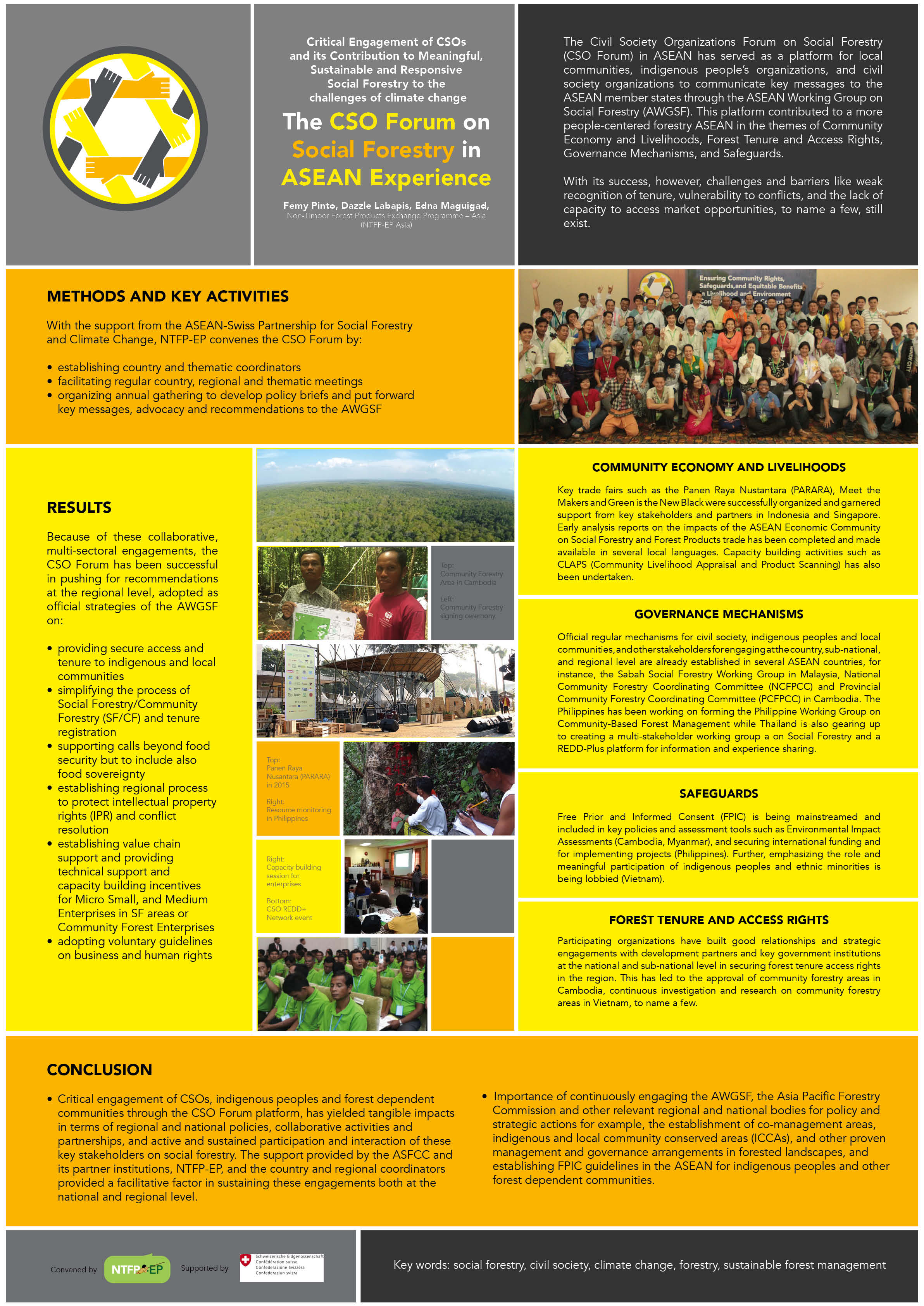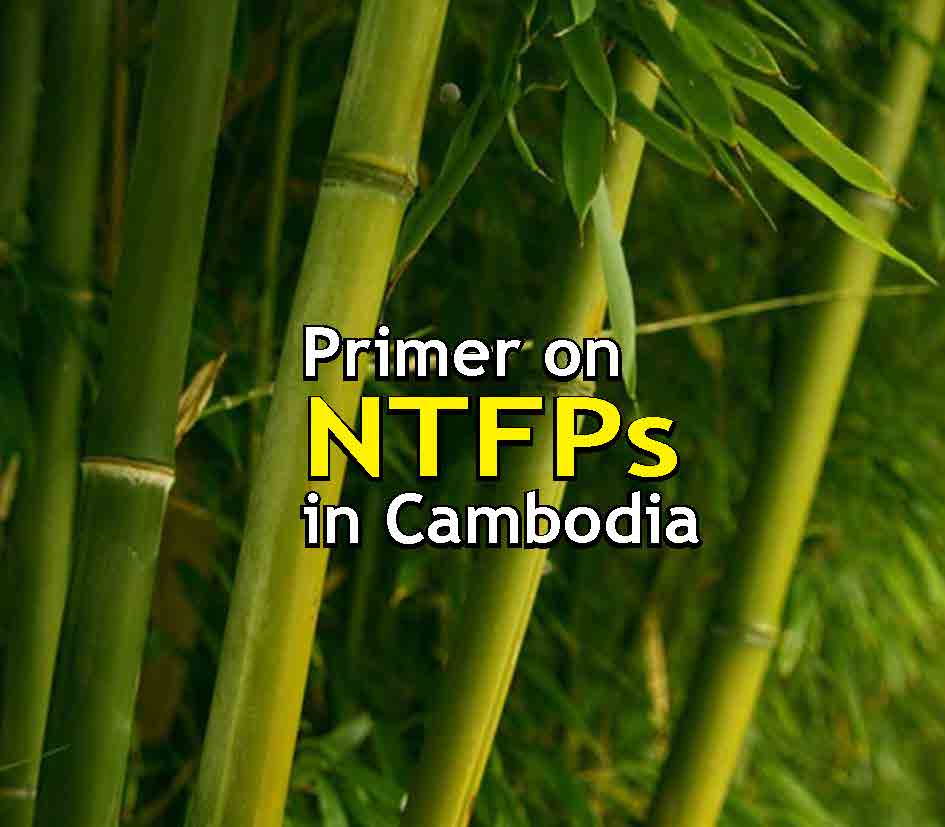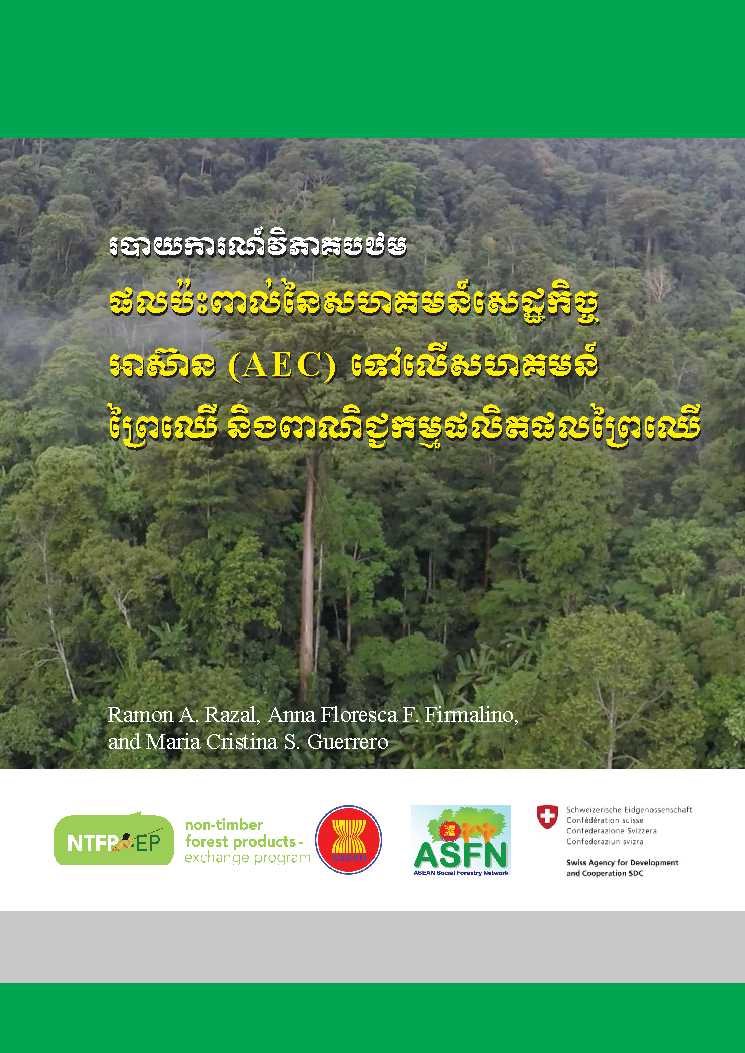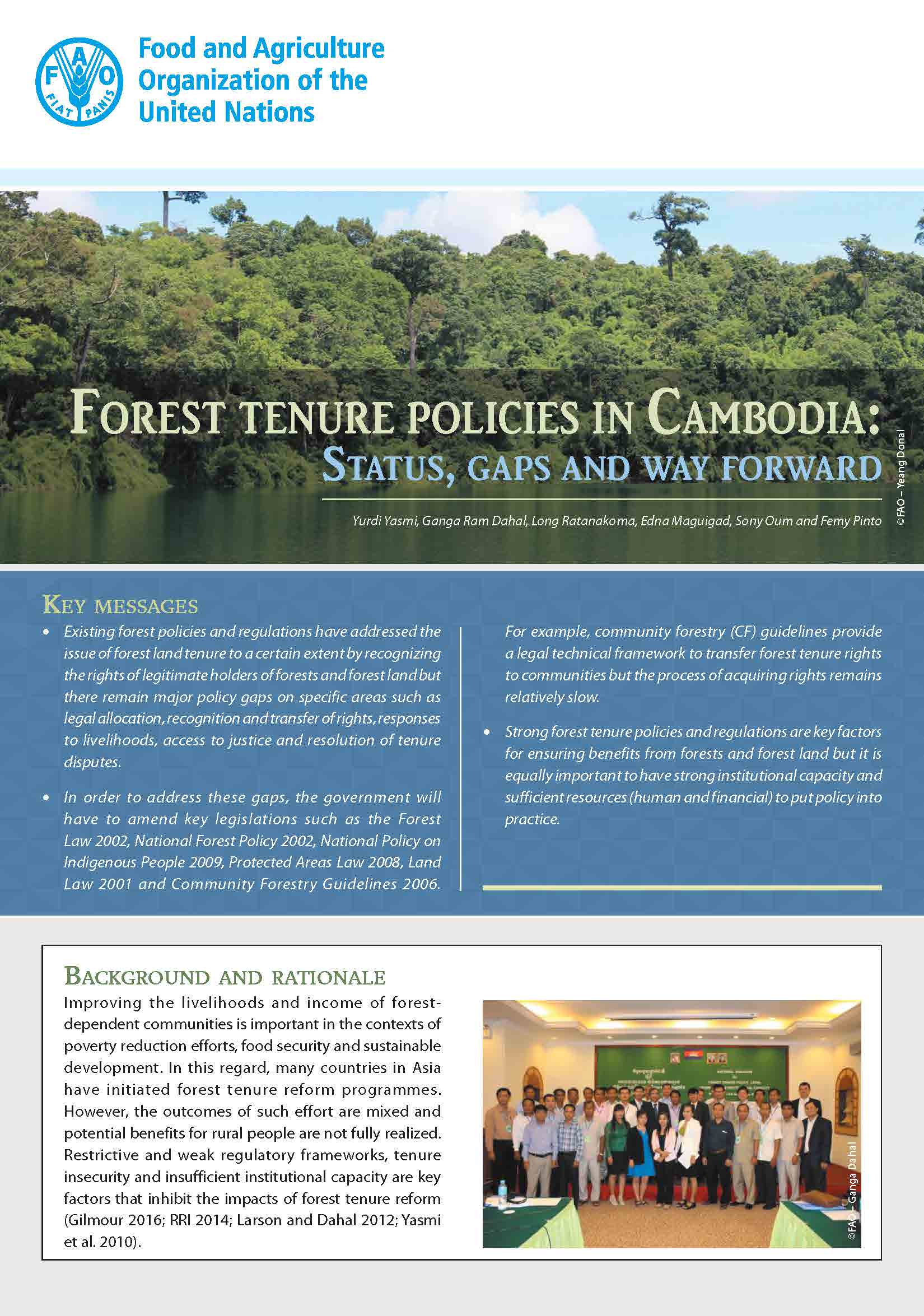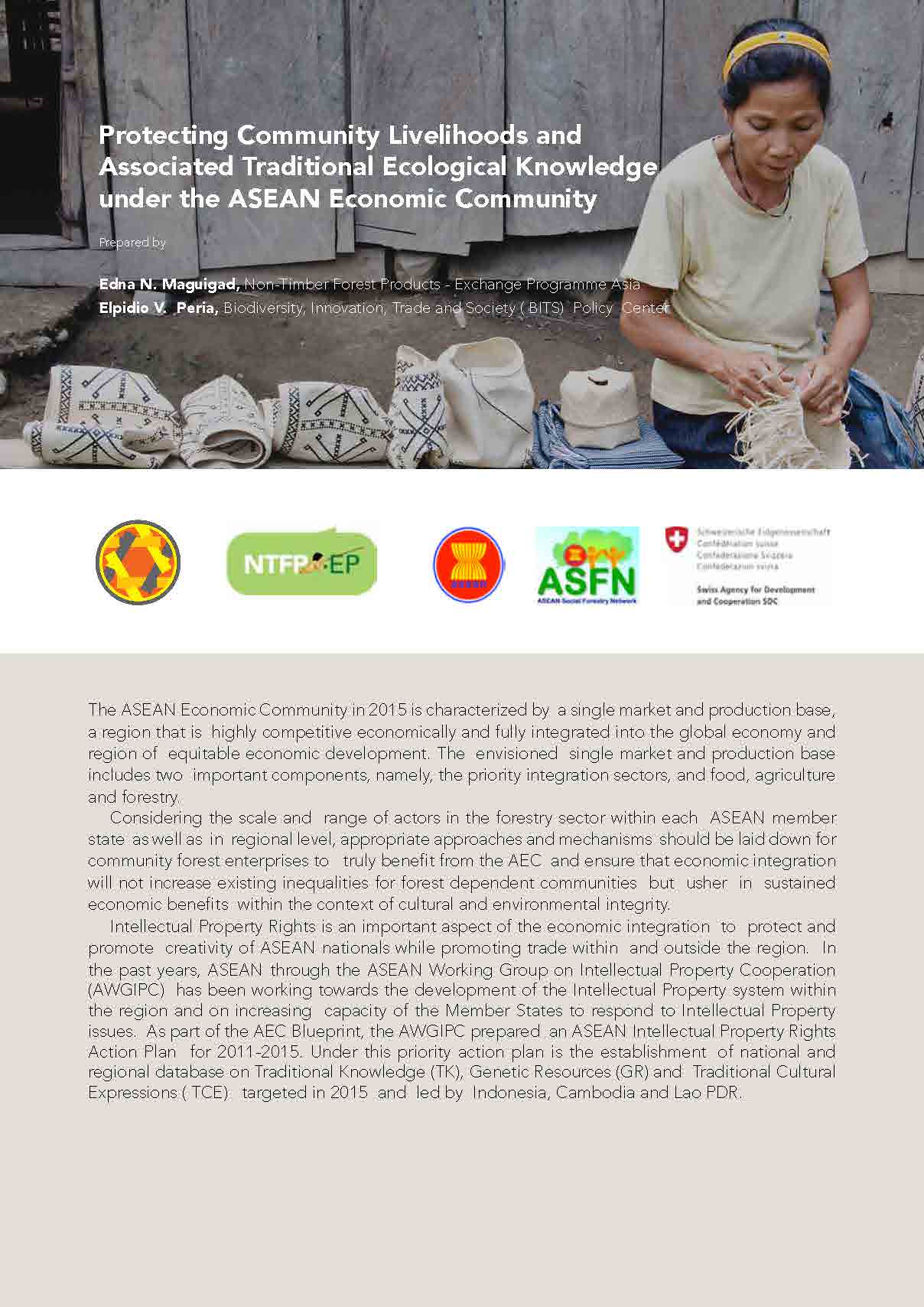A briefer on the identified challenges, key messages, and recommendations developed by the CSO Forum on Social Forestry in ASEAN during its 9th Annual Meeting last 18-20 September 2022.
Category: Briefs
- establishment of co-management areas, indigenous and local community conserved areas (ICCAs),
- adoption and support of other proven management and governance arrangements in forested landscapes, and the
- establishment of free, prior and informed consent (FPIC) regional guidelines (e.g. in the ASEAN) especially to safeguard indigenous and other forest dependent communities from critical and large-scale developments and projects in forested landscapes.
- support for community forest enterprises in strengthening their business capacity, working capital and market linkages.
Since its establishment in 2012, the Civil Society Organizations (CSO) Forum on Social Forestry in ASEAN has served as a platform for local communities, indigenous people’s organizations, and civil society organizations to consolidate and elevate key messages to the members of the ASEAN states through the ASEAN Working Group on Social Forestry (AWG-SF).
Today, over 50 participants representing representing 40 organizations from 8 countries in Southeast Asia are actively engaged in the forum.
Most of the communities in Cambodia use non-timber forest products (NTFPs) as food sources (honey, mushrooms, nuts, wild fruit, edible leaves, wild potatoes, rattan and bamboo shoots), as medicines (honey and seeds) and as building materials (rattan and bamboo) or materials for creating other products (resin).
The Law on Forestry and the Law on Protected Areas in Cambodia controls the use, harvest, transport, and to some extent, the commercialization of NTFPs by local communities living near forests and protected areas. This publication is a consolidation of the existing policies and regulations relevant to the use and management of NTFPs in the country, along with issues and recommendations to address such.
Forest Harvest is a collective mark that aims to highlight the forest source and sustainability of products, starting from those coming from community partners of the Non-Timber Forest Products–Exchange Program (NTFP-EP) network. It covers all non-timber forest products that are harvested from the forests, whether from the wild or already cultivated sources.
The label guarantees that the products meet three parameters:
Traceable Forest Source
Using Participatory Guarantee Systems (PGS) or other monitoring systems in place, products or the materials used can be traced back to well-managed community forest, whether wild or cultivated in home gardens of forest-based communities.
Sustainable
The product is harvested according to the agreed sustainable harvesting protocol for the product.
Good Quality
The product is produced according to market standards and meets existing product quality standards of the market, unless a different standard is agreed upon.
ASEAN Economic Community or AEC embodies the aspiration of regional economic integration by the 10 member states1 of the Association of Southeast Asian Nations by 31 December 2015. The AEC will have the following key characteristics: a) a single market and production base; b) a highly competitive region; c) a region of equitable economic development; and d) a region fully integrated into the global economy.
It is envisioned that the ASEAN region will become one ASEAN Community that is founded on strong economic, political, and socio-cultural partnerships among the ASEAN member states (AMS). Thus, the ASEAN Economic Community (AEC) is one the pillars of the ASEAN Community alongside the Political-Security Community (APSC) and the Socio-Cultural Community (ASCC). The economic aspects of integration will entail liberalization of trade among the AMSs including measures that will eliminate all tariffs and non-tariff barriers, enhance interconnectivity, and other measures that will allow free flow of goods, services, investment, capital and skilled labor.
The study was conducted by the Non-Timber Forest Products – Exchange Programme (NTFP-EP) with support from the ASEAN Swiss Partnership for Social Forestry and Climate Change (ASFCC). It determined the impacts (both positive and negative) of the planned economic integration on social forestry stakeholders in the ASEAN member states.
ASEAN Economic Community or AEC embodies the aspiration of regional economic integration by the 10 member states1 of the Association of Southeast Asian Nations by 31 December 2015. The AEC will have the following key characteristics: a) a single market and production base; b) a highly competitive region; c) a region of equitable economic development; and d) a region fully integrated into the global economy.
It is envisioned that the ASEAN region will become one ASEAN Community that is founded on strong economic, political, and socio-cultural partnerships among the ASEAN member states (AMS). Thus, the ASEAN Economic Community (AEC) is one the pillars of the ASEAN Community alongside the Political-Security Community (APSC) and the Socio-Cultural Community (ASCC). The economic aspects of integration will entail liberalization of trade among the AMSs including measures that will eliminate all tariffs and non-tariff barriers, enhance interconnectivity, and other measures that will allow free flow of goods, services, investment, capital and skilled labor.
The study was conducted by the Non-Timber Forest Products – Exchange Programme (NTFP-EP) with support from the ASEAN Swiss Partnership for Social Forestry and Climate Change (ASFCC). It determined the impacts (both positive and negative) of the planned economic integration on social forestry stakeholders in the ASEAN member states.
Authors: Yasmi, Y.; Dahal, G. R.; Ratanakoma, L.; Maguigad, E.; Oum, S.; Pinto, F.
Abstract:
Improving livelihoods and income of forest dependent communities is important in the context of poverty reduction efforts, food security, and achieving sustainable development goals (SDGs). In this regard, many countries in Asia have initiated forest tenure reform programmes. However, the outcome of such reform is mixed and potential benefits to rural people are not fully realised. Restrictive and weak regulatory frameworks, tenure insecurity, and insufficient institutional capacity are key factors limiting the impacts of forest tenure reform. FAO initiated a regional programme on Strengthening Forest Tenure for Sustaining Livelihoods and Generating Income in Cambodia, Nepal and Viet Nam in 2014. These three countries are referred to pilot countries. The main objective was to strengthen regulatory frameworks and institutional capacity of these countries on forest tenure to ensure better income and livelihoods for forest dependent communities. These briefs present key results of the forest tenure policy assessment based on the review of over 130 policy documents in three pilot countries (29 in Cambodia, 37 in Nepal, and 76 in Viet Nam. The country specific brief provides the current status; gaps of regulatory framework related to forest tenure in the selected pilot country and provide policy recommendations to address gaps. The regional brief provides a comprehensive and comparative scenario on forest tenure and draw learning from each other (what works where and why?)
To download the publication, click here.
This paper reports on a study undertaken by the Non-Timber Forest Products Exchange Programme to scope out processed products and associated NTFP technologies in six ASEAN countries to determine what can be potentially shared across the region that are consistent with the emergence of a global green economy as well as prepare the NTFP sector for the impending economic integration in 2015. Technology interventions that lead to better utilization of NTFPs and consequently expand opportunities not only in improving incomes of forest-dependent resource gatherers but also contribute to the national economy through trade of value-added NTFPs were documented. Raising awareness on the possibilities for increasing returns from NTFPs through transformative yet sustainable technologies that yield commercially-viable products empower those who adopt them to make more decisions that are more favorable to them and the community to which they belong.
The ASEAN Economic Community in 2015 is characterized by a single market and production base, a region that is highly competitive economically and fully integrated into the global economy and region of equitable economic development. The envisioned single market and production base includes two important components, namely, the priority integration sectors, and food, agriculture and forestry.
Considering the scale and range of actors in the forestry sector within each ASEAN member state as well as in regional level, appropriate approaches and mechanisms should be laid down for community forest enterprises to truly benefit from the AEC and ensure that economic integration will not increase existing inequalities for forest dependent communities but usher in sustained economic benefits within the context of cultural and environmental integrity.
Intellectual Property Rights is an important aspect of the economic integration to protect and promote creativity of ASEAN nationals while promoting trade within and outside the region. In the past years, ASEAN through the ASEAN Working Group on Intellectual Property Cooperation (AWGIPC) has been working towards the development of the Intellectual Property system within the region and on increasing capacity of the Member States to respond to Intellectual Property issues. As part of the AEC Blueprint, the AWGIPC prepared an ASEAN Intellectual Property Rights Action Plan for 2011-2015. Under this priority action plan is the establishment of national and regional database on Traditional Knowledge (TK), Genetic Resources (GR) and Traditional Cultural Expressions ( TCE) targeted in 2015 and led by Indonesia, Cambodia and Lao PDR.


